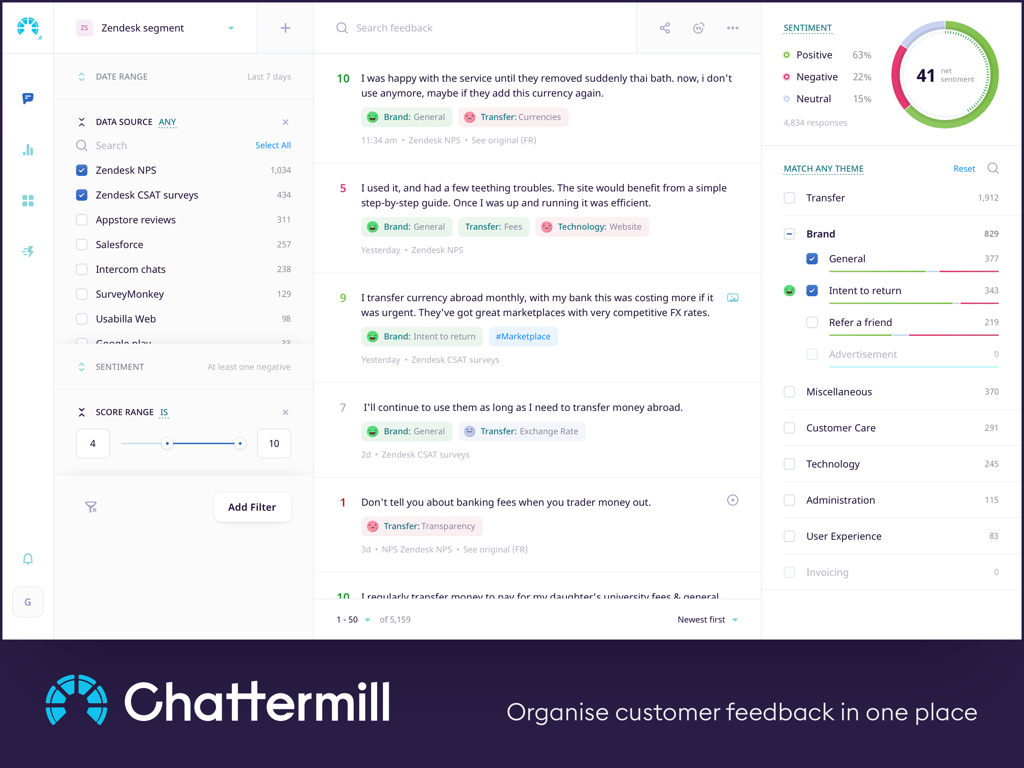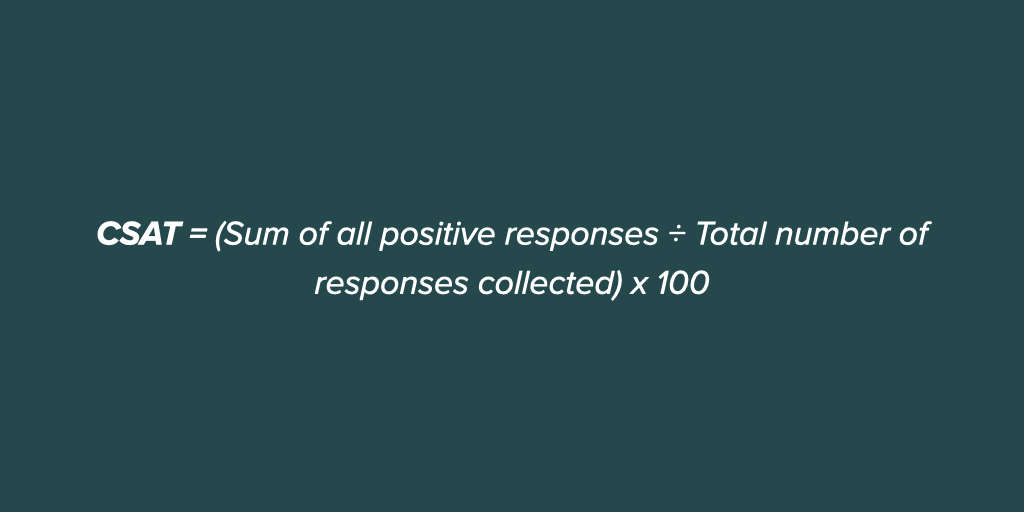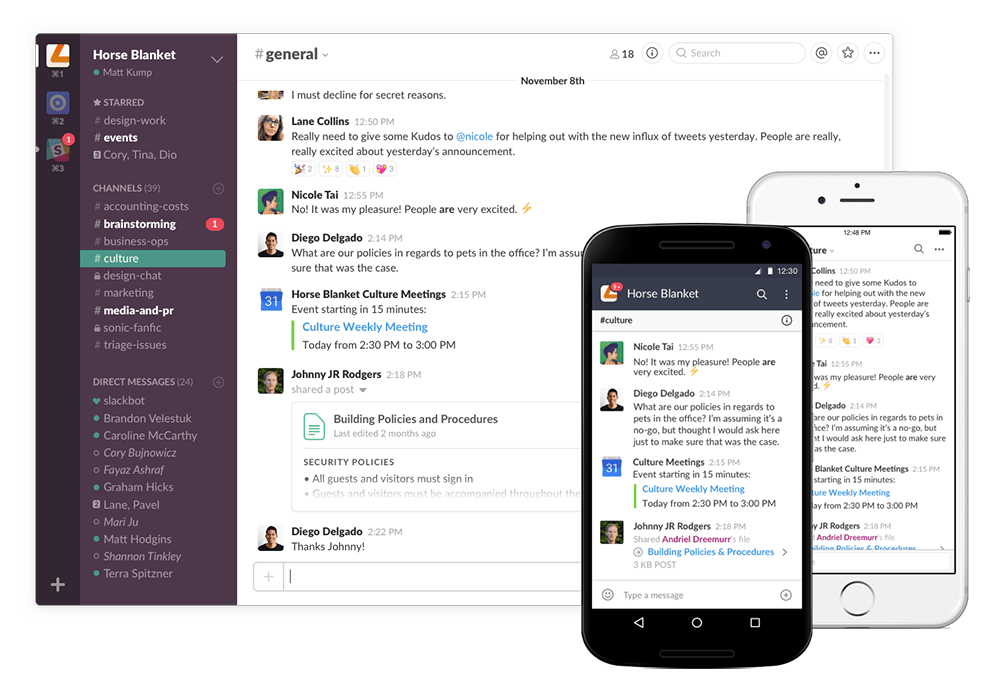Article • 23 min read
Voice of the Customer (VoC): Streamline data collection + analysis to inform strategy
Are you truly listening to your customers? Use Voice of the Customer programs to gather and analyze feedback so you can enhance your customer experience.
Por Lisa Hayes, Senior Director, Customer Insights & Innovation
Última atualização em October 2, 2024
Every business needs a strategy to collect and analyze customer feedback. Customers will talk about your brand—sometimes to your team members—across several channels. Without a way to consolidate this input, your support team may miss out on valuable cues directly from your customers.
Learn how Voice of the Customer (VoC) programs can help you capture customer feedback from multiple channels and easily share data across departments so you can keep improving your brand, products, services, and overall customer experience.
Table of contents
- What is a Voice of the Customer program and what does it entail?
- Benefits of a Voice of the Customer strategy and program
- How to build a Voice of the Customer program: 6 strategies
- VoC best practices
- Voice of the Customer data collection techniques
- Questions to consider for your Voice of the Customer research
- How to apply Voice of the Customer analysis
- Voice of the Customer examples
What is Voice of the Customer (VoC)?
Voice of the Customer (VoC) is a methodology that businesses use to collect and analyze customer feedback about their brand, products, services, and customer experience.
A successful VoC strategy requires buy-in from every department, as everyone plays a role in shaping the customer experience. Teams must agree on how to collect feedback, share results, and use insights to refine their piece of the customer journey.
What is a Voice of the Customer program and what does it entail?
Voice of Customer programs streamline the process of managing customer feedback and understanding your audience’s needs. The program consolidates feedback, preventing important input from slipping through the cracks.
This input comes from various sources, including:
Customer surveys
Social media posts
Feedback forms
Community forums
Support interactions
VoC programs allow each department to connect, engage, and align on how to meet customer needs throughout the customer journey. They also help companies determine where they need to improve to provide better customer experiences.
How could a Voice of the Customer program impact your business?
The Zendesk Customer Experience Trends Report 2022 found that a high-quality customer experience is one of the best predictors of customer loyalty: 81 percent of shoppers who have a positive customer experience are likely to buy more products and services from the company.
Here are a few ways VoC programs can impact your business:
Strengthen customer loyalty
Boost innovation, encouraging your team to try new ideas and solutions
Help you identify where you can customize your products or services to fit the needs of your customers
Benefits of a Voice of the Customer strategy and program
Companies that use Voice of the Customer tools and programs to speak with buyers see benefits across their organizations.
How to build a Voice of the Customer program: 6 strategies
Whether you’re managing support for a small or large business, these six steps will help you set up a successful VoC program.

1. Get program buy-in from key stakeholders
A VoC program can originate from the support team, but its success often depends on contributions from other teams. Improving the customer experience is in the whole company’s best interest, and sharing program objectives between departments can help ensure the program has a far-reaching impact.
Say the customer support manager of a large organization wants to gather feedback on how to increase customer satisfaction with live chat. They can loop in:
- The finance team, in case it needs special funding
- IT because the results may require switching live chat technology providers
- The sales team, as the results may influence how they use live chat
In this scenario, taking the time to get program buy-in could result in higher satisfaction with live chat as well as higher sales from it. Plus, you’ll improve employee engagement and collaboration across teams in the process.
2. Determine which VoC channels to focus on
Support teams have never had access to more channels for customer communication—email, SMS, social media, chat, messaging apps, and more. Figure out which channels will bring you the most valuable VoC input to help your agents make the most of their time.
Your chosen channels must balance the quantity of feedback with the quality. You may have a larger following on Instagram, for example, but you should focus on Facebook if more customer conversations take place on that platform. If you send a five-question survey via email, but only a fraction of your customers completes it, you may need to host an in-person focus group to get high-quality feedback.
The channels should also make it easy for customers to provide their input. Say you want to send a customer satisfaction survey. Live chat or an interactive voice response (IVR) system are ideal channels for such feedback. The customer can respond with the press or click of a button.
3. Adopt and integrate software to track the feedback
Invest in customer feedback software to set up your surveys and automatically send them to your target customers via your selected channels. The software should also calculate average numerical ratings from CSAT or Net Promoter Score® (NPS) surveys and analyze the sentiment of survey responses. These features save you time, ensure accuracy, and store the results for future reference.
With sentiment analysis, tools find words or phrases in blocks of text that indicate how customers feel about your brands or products. According to Gartner, 60 percent of organizations with VoC programs will use voice and text analysis alongside surveys by 2025.
Integrate your customer feedback software with other platforms to increase its power. For example, Zendesk’s conversational customer relationship management (CRM) tool supports the Chattermill app, which aggregates customer feedback and conversations all in one place. Together with Chattermill, the CRM can provide hidden insights within customer feedback so you know what your customers are saying.
4. Look for trends in your VoC research
If your customer feedback software offers analytics dashboards, use the reporting features to quickly spot trends in CSAT and NPS ratings, sentiment scores, and keywords in survey responses.
CSAT trends are fairly straightforward. If the CSAT average is above 9, your customers are happy across the board. An average of 2 or below means you have a problem.
It’s one thing to find out that customers are unsatisfied, but why are they unsatisfied? Take a look at customers’ comments alongside their CSAT ratings to understand their scores.
Consider implementing sentiment analysis, too (if your customer feedback tool offers that feature). It allows you to quickly gauge whether input around certain topics is generally positive, negative, or neutral. Most tools present this data in an easy-to-follow dashboard.

5. Follow up with customers
Thank customers who took the time to complete a Voice of the Customer survey or participate in a focus group. Then, tailor your follow-up according to how customers responded to your outreach.
Be especially proactive with customers who report one or more negative experiences with your products, services, or brand. While it’s fine to send unsatisfied customers a thank-you note for their participation, you’ll sound aloof as a company if you don’t also tell them how you plan to make improvements based on their feedback. Include a gift or discount on another purchase as an extra incentive to prevent them from churning.
6. Keep collecting customer feedback
You’ve collected input about your product, so your engineers know which features they should add. That’s great, but don’t stop there. VoC involves continually gathering feedback. After you make product and customer experience updates, you’ll want to ask your audience how they like those changes.
If improving live chat was the focus of one VoC program, for example, send a follow-up note to see if your improvements result in higher CSAT scores. Ask open-ended questions about their experiences with the new feature.
With each new VoC program comes the opportunity to make adjustments to your feedback strategy. You may decide to switch from chat to email, ask more questions, or segment responses differently. Eventually, the VoC feedback loop will become part of your company culture.
VoC best practices
To make the most of the information gathered through your Voice of the Customer program, you don’t need to use VoC companies. Follow these best practices and start on the right foot.
Collect feedback across multiple channels
Every customer interaction has value, so it’s important to capture feedback across different channels throughout the entire customer journey. Feedback can come from direct and indirect sources, including:
Customer surveys
CSAT and NPS scores
Community forum comments
Conversations with customer service representatives
Support tickets
Social media messaging
Advisory boards
1:1 conversations with customer-facing teams and individuals
Sales representatives
Product pilot and early access programs
Personalize your Voice of the Customer requests
Our Trends Report found that 68 percent of customers expect all experiences to be personalized—that includes the process of collecting feedback. You want to build trust and loyalty with your customers, so personalize each interaction to deliver a great brand experience.
For instance, you can plan your feedback request to coincide with customer milestones or achievements. If you notice a sudden change in their behavior, it’s also a good opportunity to reach out and see if your company needs to adjust something. Tailor your questions and keep them relevant, and the customer should give you helpful feedback.Increase collaboration across departments with a CRM
A conversational CRM enables teams to house and share data in one location, breaking down internal silos and improving collaboration. When all departments have access to customer feedback, interaction history, contact information, and more, they also have the context needed to personalize conversations—and customers don’t have to repeat themselves. This makes buyers feel heard and valued, fostering retention and loyalty.Make changes based on your data
After you collect and review the customer feedback, use these new insights to make improvements—whether that means tweaking your products, services, or marketing strategy.
Keep adjusting the VoC process as your business evolves and customer needs shift over time. Consistently gathering and analyzing VoC data will help you anticipate changes and stay one step ahead of your competition.
CX Accelerator report
Uncover personalized findings and action items for your business.
Voice of the Customer data collection techniques
There’s no such thing as a “one-size-fits-all” VoC program. Explore popular Voice of the Customer techniques and strategies for collecting data so you can identify the ones that best fit your business.
Net Promoter Score® (NPS)
The NPS® survey is a relatively simple way to assess customer loyalty. Businesses send customers a one-question survey that asks, “How likely are you to recommend us to someone you know?” Customers can then respond on a scale of 0 to 10.
Zendesk’s NPS® survey tool also asks customers to share the reason for their rating and provides space for them to write a response. Over half of NPS® survey respondents will leave additional open-ended feedback, which helps determine:
Why detractors (customers who leave a rating between 0 and 6) are having a bad customer experience
What promoters (customers who leave a rating of 9 or 10) value most about your company
What issues are preventing passives (customers who leave a rating of 7 or 8) from becoming promoters

Customer satisfaction (CSAT) rating
CSAT surveys invite customers to rate a particular interaction or experience with your brand—whether that’s buying a product or talking to a support agent. Email, SMS, and chat are common channels for sending CSAT surveys.
After a support interaction, for example, many companies send customers CSAT surveys that ask, “How would you rate your recent experience?” Customers can rank their experience on a scale of 1 to 10 or choose from options ranging from “very dissatisfied” to “very satisfied.”
The more CSAT scores your company collects, the more touchpoints you can analyze. You can also ask additional customer satisfaction survey questions—including demographic details, product usage, and follow-up questions—to compile an even richer set of data. The higher the final percentage, the more satisfied customers are with the experience.

Customer surveys
CSAT and NPS are popular surveys because they’re so straightforward. But sometimes, you’ll want to ask a customer more than just one question.
Be careful not to ask too many questions—the longer the survey, the more likely a customer won’t finish it. SurveyMonkey found that abandonment rates increased 5 to 20 percent for surveys that took more than seven to eight minutes to complete.
Try to build short surveys and write questions that are easy to understand (aim for an eighth-grade reading level). You may also need to incentivize potential survey-takers with a reward, such as a discount, coupon, or gift.
Community forums
An active community forum is an excellent source of direct and indirect feedback. This owned platform on a company’s website can provide a powerful combination of customer support, social networking, and honest communication about a brand’s products or services.
Regularly check on the forum to see what customers are talking about, and use that information to design better practices, products, and resources.
Customers often use forums to troubleshoot issues with a software product. It’s not uncommon for participants to discover multiple solutions for the same problem by interacting with each other. Support agents can use these conversations to expand their knowledge of your products and the assistance they provide. Agents can also respond directly to customers and help them resolve issues in real time.
Customer interviews
A classic Voice of the Customer example is the customer interview. Though more time-consuming than an automated survey, an interview with an individual buyer can allow you to dig deeper into someone’s feelings about your brand, services, or products.
Customer interviews can happen over the phone, through email exchanges, or in person. Pick an interviewee who reflects your overall audience or a key demographic you’re trying to learn more about.
Focus groups
Focus groups help you conduct market research using group interviews. You can guide participants with a list of questions or let them freely discuss a topic of interest, such as what they consider an ideal customer support experience. Like customer interviews, focus groups can occur virtually or in person.
Customer-facing employees
Sales reps and customer service teams interact with buyers daily and can be direct sources of customer feedback. Interview these employees regularly to discover customers’ thoughts and perceptions of your brand.
Businesses can listen to recorded phone calls and mine conversations for passive feedback through comments, tone, or demeanor. Agents can also document when customers intentionally offer feedback and submit this information to management through the appropriate channels.
Chatbot
As customer service evolves and more interactions occur online, chatbots are becoming commonplace. Our CX Trends Report shows that 26 percent of businesses allocated a quarter or more of their customer service tech budget to AI last year.
Integrating your conversational CRM with chatbots on different messaging platforms—like WhatsApp and Facebook Messenger—can help you meet customers where they are and collect valuable feedback.
Chatbots can capture feedback in various ways, including by:
Logging response rates
Asking for feedback at the end of an interaction
Creating special offers for customers based on their conversation history and preferences
Social media
Your current and former customers are already talking about your brand on social media, so why not see what they’re saying? Incorporating social listening—the act of monitoring online discussions about your brand—into your VoC strategy can enable you to gather key insights.
Platforms like Facebook, Instagram, Twitter, and LinkedIn can provide you with honest positive and negative feedback. Social listening is especially helpful because it allows you to compare complaints, compliments, questions, and sentiments across different channels.
Online reviews
Online reviews offer a wealth of Voice of the Customer data. Sites like Google Reviews, Yelp, Trustpilot, and Angi can help you capture VoC data without having to reach out to customers.
A staggering 93 percent of customers read online reviews before making a purchase, making it important to monitor and respond to the negative reviews that come in. It’s also a great opportunity to enhance your online reputation by staying active on threads and responding to positive reviews.
Questions to consider for your Voice of the Customer research
A VoC program succeeds only when customer feedback is actionable. Obtaining such insights starts with asking a tightly worded question that customers can answer quickly and specifically. The questions can focus on your products, services, or brand.
How to apply Voice of the Customer analysis
Once you’ve established your process for gathering and analyzing VoC data, use it to refine the customer experience across your entire business.
Measuring success
When analyzing your VoC data, consider every phase of the customer journey to understand how each metric applies and how to spot patterns. You can measure data like:
CSAT score
NPS score
Customer lifetime value (CLV)
Customer loyalty index (CLI)
Number of referrals
Pay close attention to the number of surveys you sent out and the number returned. This provides great data on which customer groups prefer which channels. For example, if you send 100 online surveys to an older demographic and receive only a few responses, you might learn that they prefer voice or paper surveys instead.
Identifying trends
VoC data can help you identify trends in your customer segments so you can stay ahead of the game with your current customers and prospects. You may discover shifts in areas like:
Preferred channels of communication
Customer sentiment
Buying behavior
Opinion of customer experience
The desire for more self-service options
Understanding these trends allows you to know what your customers prefer and what you need to prioritize.
Managing a knowledge base
Use support tickets and customer conversations to determine which inquiries to add to your knowledge base content. A knowledge base is a collection of articles covering common support issues. Customers who find answers here don’t need to contact support, saving them time and freeing up agents to focus on more complex issues.
Consumers want self-service options, too. According to our CX Trends Report, 89 percent of shoppers will spend more with companies that allow them to find answers online without having to contact anyone. Additionally, 70 percent say they expect a company to have a self-service portal or content available to them.
Analyze the topics of support tickets that agents resolved in a single exchange and that didn’t require follow-up. These topics are good candidates for easily digestible knowledge base articles. The more a topic shows up in support tickets, the more urgent it might be to cover it in your knowledge base.
Training opportunities
Our CX Trends Report revealed that 68 percent of customers feel like most businesses need to improve the training of their customer service reps. Luckily, VoC analysis can lead to training opportunities for agents, helping them resolve problems more quickly and efficiently.
CSAT surveys can help uncover specific training needs. Over a month, send CSAT surveys after each support interaction with the open-ended question, “How can we improve your support experience?” Analyze the comments from surveys that skew negative and look for common themes.
Recurring responses such as “Agent was short with me” might mean that the team needs training in customer empathy. If complaints about the length of support interactions revolve around a single product, you may have agents who lack a thorough understanding of it. Schedule a training session with the product team to ensure all agents are on the same page.
Voice of the Customer examples
Voice of the Customer impacts a wide range of customer experiences, regardless of the size and mission of your company. Here are a few Voice of Customer examples of businesses using VoC programs successfully.
Harbor Path: Improving patient experiences
Healthcare nonprofit Harbor Path helps hospitals provide life-saving medication to the uninsured. Patients in need complete an online application, and if approved, Harbor Path connects them to a provider to pick up the medication.

Harbor Path uses Voice of the Customer to better understand patients’ needs and communicate those needs to donors who cover the drug costs. In one program, the nonprofit analyzed thousands of patient applications and learned that demand for Naloxone—a drug it didn’t offer at the time—was increasing to combat the opioid epidemic in a particular state. When Harbor Path presented this data to that state, the nonprofit secured funding quickly.
VoC provided customer insights that improved the experience of new patients while helping hospitals offer better care.
Homebridge: Making customers feel heard
Homebridge’s mission is to simplify the home mortgage process. Applying for a loan is often quite stressful for first-time buyers, so Homebridge uses feedback to make sure its support team exceeds customer expectations.
Homebridge uses Trustpilot to gather and monitor customer reviews on various issues, primarily the responsiveness of customer support. A Zendesk integration converts negative reviews into support tickets and escalates them in agent workflows. Agents can then reach out proactively.

Knowing how to do Voice of the Customer properly allowed Homebridge to better understand its customers and build relationships with them. According to Ben Chapman, director of client-facing experience and analytics at Homebridge, these integrations “allow us to see and interact with customers and manage relationships that we haven’t started yet or that we want to retain.”
Slack: Seamlessly assisting with scalability
Slack picked Zendesk as its support solution in 2013 when it was still in the beta stage. By using Zendesk, the company knew it would be able to connect with customers through omnichannel communication and also automate feedback options through a ticketing system.

The Zendesk API allows Slack users to contact support through a feedback command built directly into the Slack platform. This seamlessly generates a ticket in the background and routes it to the right team for handling. Users can even report bugs through the app, making it easier for engineers, designers, and product managers to collect feedback and expedite fixes.
“We just ask our customers to tell us what their problem is, and then we’ve learned to interpret that,” says Lindsay Schaur, director of customer experience operations at Slack. Zendesk has helped Slack agents maintain a CSAT score close to 100 percent—across the board.
Stay ahead of the competition with Voice of the Customer programs

Almost all businesses claim to be customer-focused, but few truly rise to the occasion. VoC programs help companies stay customer-centric by providing a steady stream of feedback that informs their product, service, and brand development. Set up a VoC program to quickly capture customer input, act on that feedback, and keep buyers happy.
NPS, Net Promoter, and Net Promoter Score have registered trademarks of software company, Satmetrix Systems, Inc.; management consulting company, Bain & Company, Inc.; and management consultant, Fred Reichheld.
